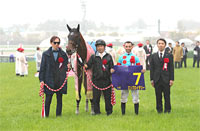Oka Sho (Japanese 1000 Guineas) (G1) - Data Analysis
G1 race for fillies that kicks off the classic races
The Oka Sho (Japanese 1000 Guineas) is the first of the Classic races that represent the pinnacle of spring racing. Three-year-old fillies will compete for the title in a mile-long race at Hanshin Racecourse. We have identified some trends in this race based on an analysis of results over the last 10 years, and present our findings below.
Race favorites in contention for top positions, but not fully reliable
Over the last 10 years, race favorites delivered five Top 3 finishers including one winner. As half of them finished 4th or lower, we should not fully place our trust in them. At the same time, however, the data does not point toward strong performances by dark horses either, with runners backed as 9th or lower only producing two Top 3 finishers. Nearly all Top 3 finishers were backed as 8th favorite or higher. We should therefore focus on runners backed as 8th or higher as win contenders, and also select other runners from the same group. [Table 1]
[Table 1] Performance by favoritism (last 10 years)
| Favoritism |
Performance
[1st-2nd-3rd-4th or lower] |
Win ratio |
Top 2 ratio |
Top 3 ratio |
| 8th favorite or higher |
10-10-8-52 |
12.5% |
25.0% |
35.0% |
| 9th favorite or lower |
0-0-2-96 |
0% |
0% |
2.0% |
Focus on body weight
The 10 previous winners all weighed in at 460kg-499kg. While lighter runners of 459kg or below also delivered Top 3 finishers, some highly favored runners in this group failed to live up to expectations. Examples include 2022 race favorite Namur (426kg, beaten to 10th), 2021 3rd favorite Meikei Yell (458kg, beaten to 18th), and 2015 race favorite Rouge Buck (444kg, beaten to 9th). [Table 2]
[Table 2] Performance by body weight (last 10 years)
| Body weight |
Performance
[1st-2nd-3rd-4th or lower] |
Win ratio |
Top 2 ratio |
Top 3 ratio |
| 459kg or below |
0-5-5-92 |
0% |
4.9% |
9.8% |
| 460-499kg |
10-5-5-50 |
14.3% |
21.4% |
28.6% |
| 500kg or above |
0-0-0-6 |
0% |
0% |
0% |
In addition, looking at performances in terms of changes in body weight from the previous race, we find that runners coming in with a heavier weight than in their previous race performed poorly. For example, 2022 2nd favorite Circle of Life, 2019 race favorite Danon Fantasy, and 2016 race favorite Major Emblem all finished 4th. In other words, runners coming in with a heavier body weight than in their previous race have suffered defeats. [Table 3]
[Table 3] Performance by change in body weight from previous race (last 10 years)
| Change in body weight from previous race |
Performance
[1st-2nd-3rd-4th or lower] |
Win ratio |
Top 2 ratio |
Top 3 ratio |
| Decrease |
7-5-7-93 |
6.3% |
10.7% |
17.0% |
| No change |
2-2-3-15 |
9.1% |
18.2% |
31.8% |
| Increase |
1-3-0-40 |
2.3% |
9.1% |
9.1% |
Top 3 finish and backing of 3rd favorite or higher in previous race are good selection criteria
The 24 Top 3 finishers, including the last 10 winners, had all finished in the Top 3 of their previous race. Six runners that had finished 4th or lower last time out also made it into the Top 3, but these had all contested the Tulip Sho in their previous race. Excluding runners coming from Tulip Sho, runners that have finished 4th or lower in their previous race are likely to struggle. [Table 4]
[Table 4] Performance by finish in previous race (last 10 years)
| Finish in previous race |
Performance
[1st-2nd-3rd-4th or lower] |
Win ratio |
Top 2 ratio |
Top 3 ratio |
| Top 3 |
10-7-7-98 |
8.2% |
13.9% |
19.7% |
| 4th or lower |
0-3-3-50 |
0% |
5.4% |
10.7% |
Looking at favoritism in the previous race, we note that runners that were backed as 3rd favorite or higher in their previous race achieved strong success ratios. Of the seven Top 3 finishers that were backed as 4th favorite or lower in their previous race, six came from the Tulip Sho. In other words, runners that have previously contested a race other than the Tulip Sho backed as 4th favorite or lower should be avoided. [Table 5]
[Table 5] Performance by favoritism in previous race (last 10 years)
| Favoritism in previous race |
Performance
[1st-2nd-3rd-4th or lower] |
Win ratio |
Top 2 ratio |
Top 3 ratio |
| 3rd favorite or higher |
9-8-6-78 |
8.9% |
16.8% |
22.8% |
| 4th favorite or lower |
1-2-4-70 |
1.3% |
3.9% |
9.1% |
Runners coming from a non-graded race struggle
Looking at performances by previous race, we observe that 29 of the 30 Top 3 finishers had contested a graded race in their previous race. The only strong performer among runners coming from a non-graded race was 2020 winner Daring Tact, who had previously contested the Elfin Stakes and ultimately won the Fillies’ Triple Crown. [Table 6]
[Table 6] Performance by previous race (last 10 years)
| Previous race |
Performance
[1st-2nd-3rd-4th or lower] |
Win ratio |
Top 2 ratio |
Top 3 ratio |
| Graded race |
9-10-10-112 |
6.4% |
13.5% |
20.6% |
| Non-graded race |
1-0-0-36 |
2.7% |
2.7% |
2.7% |
Also, when we analyze which previous graded races produced strong performers, we unsurprisingly observe that runners coming from the Tulip Sho, a trial race run over the same course, have often fared well. In addition, the smaller group of runners coming from G1 races for two-year-olds run over the same course, such as the Hanshin Juvenile Fillies and the Asahi Hai Futurity Stakes, also achieved high success ratios. [Table 7]
[Table 7] Performance by previous race (last 10 years)
| Previous race |
Performance
[1st-2nd-3rd-4th or lower] |
Win ratio |
Top 2 ratio |
Top 3 ratio |
| Tulip Sho |
4-8-6-30 |
8.3% |
25.0% |
37.5% |
| Hanshin Juvenile Fillies |
1-2-0-3 |
16.7% |
50.0% |
50.0% |
| Hochi Hai Fillies’ Revue |
1-0-2-46 |
2.0% |
2.0% |
6.1% |
| Daily Hai Queen Cup |
1-0-1-17 |
5.3% |
5.3% |
10.5% |
| Asahi Hai Futurity Stakes |
1-0-0-1 |
50.0% |
50.0% |
50.0% |
| Nikkan Sports Sho Shinzan Kinen |
1-0-0-1 |
50.0% |
50.0% |
50.0% |
| Fairy Stakes |
0-0-1-4 |
0% |
0% |
20.0% |
| Flower Cup |
0-0-0-8 |
0% |
0% |
0% |
| Kisaragi Sho |
0-0-0-1 |
0% |
0% |
0% |
| Arlington Cup |
0-0-0-1 |
0% |
0% |
0% |
| Other race |
0-0-0-34 |
0% |
0% |
0% |
Seek out the winner!
Shared features are high finish, high favoritism, and fast closing speed in mile-long race last time out
All but one of the last nine winners had contested a 1,600m turf race in their previous race. In addition, all nine winners had been backed as 3rd favorite or higher and finished in the Top 3 of that race. Moreover, with the exceptions of Reine Minoru (turf 1,400m race last time out) and Let’s Go Donki (muddy track last time out), all runners displayed a fast closing speed in their previous race, with an estimated time over the final three furlongs of 34.6 seconds or lower. [Table 8]
[Table 8] Winners’ performance in previous race by distance, finish, favoritism, and estimated time over final three furlongs (last nine years)
| Year |
Winner |
Distance in previous race |
Finish in previous race |
Favoritism in previous race |
Estimated time over
final three furlongs in previous race |
| 2014 |
Harp Star |
1600m |
1st |
1st favorite |
33.7s |
| 2015 |
Let’s Go Donki |
1600m |
3rd |
2nd favorite |
36.6s |
| 2016 |
Jeweler |
1600m |
2nd |
1st favorite |
33.0s |
| 2017 |
Reine Minoru |
1400m |
2nd |
1st favorite |
35.0s |
| 2018 |
Almond Eye |
1600m |
1st |
1st favorite |
34.4s |
| 2019 |
Gran Alegria |
1600m |
3rd |
1st favorite |
34.6s |
| 2020 |
Daring Tact |
1600m |
1st |
3rd favorite |
34.0s |
| 2021 |
Sodashi |
1600m |
1st |
1st favorite |
34.2s |
| 2022 |
Stars on Earth |
1600m |
2nd |
1st favorite |
34.2s |
(Yodohito Himezono)
|




















